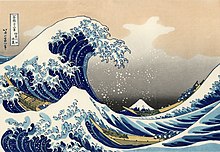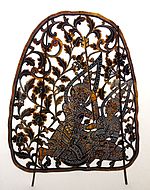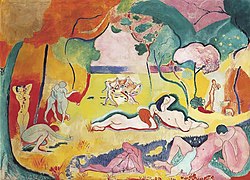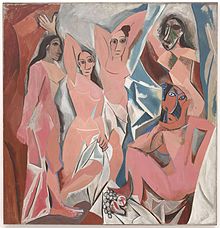History of art - Asian art
Asian art
Eastern civilization broadly includes Asia, and it also includes a complex tradition of art making. One approach to Eastern art history divides the field by nation, with foci on Indian art, Chinese art, and Japanese art. Due to the size of the continent, the distinction between Eastern Asia and Southern Asia in the context of arts can be clearly seen. In most of Asia, pottery was a prevalent form of art. The pottery is often decorated with geometric patterns or abstract representations of animals, people or plants. Another very widespread form of art was, and is, sculpture.
Indian
The Indus Valley Civilisation made anthropomorphic figures. Most famous are the Dancing Girl and the Priest-King. This civilisation made also many clay pots, most of them decorated with geometric patterns. They made seals decorated with animals, anthropomorphic figures and their script. The Indus script (also known as the Harappan script) is a corpus of symbols produced by the Indus Valley Civilization during the Kot Diji and Mature Harappan periods between 3500 and 1900 BCE. Most inscriptions containing these symbols are extremely short, making it difficult to judge whether or not these symbols constituted a script used to record a language, or even symbolise a writing system. In spite of many attempts, the "script" has not yet been deciphered, but efforts are ongoing. There is no known bilingual inscription to help decipher the script, nor does the script show any significant changes over time. However, some of the syntax (if that is what it may be termed) varies depending upon location.
Early Buddhists in India developed symbols related to Buddha. Bhutanese painted "thangkas" that shows Buddhist iconography. The major survivals of Buddhist art begin in the period after the Mauryans, from which good quantities of sculpture survives from some key sites such as Sanchi, Bharhut and Amaravati, some of which remain in situ, with others in museums in India or around the world. Stupas were surrounded by ceremonial fences with four profusely carved toranas or ornamental gateways facing the cardinal directions. These are in stone, though clearly adopting forms developed in wood. They and the walls of the stupa itself can be heavily decorated with reliefs, mostly illustrating the lives of the Buddha. Gradually life-size figures were sculpted, initially in deep relief, but then free-standing. Mathura was the most important centre in this development, which applied to Hindu and Jain art as well as Buddhist. The facades and interiors of rock-cut chaitya prayer halls and monastic viharas have survived better than similar free-standing structures elsewhere, which were for long mostly in wood. The caves at Ajanta, Karle, Bhaja and elsewhere contain early sculpture, often outnumbered by later works such as iconic figures of the Buddha and bodhisattvas, which are not found before 100 CE at the least.
 Priest-King, c. 2500 BC, in the National Museum of Pakistan(Karachi, Sindh, Pakistan)
Priest-King, c. 2500 BC, in the National Museum of Pakistan(Karachi, Sindh, Pakistan) Priest-King from profile
Priest-King from profile Dancing Girl, in the National Museum, New Delhi (India)
Dancing Girl, in the National Museum, New Delhi (India)- Harappan seals, British Museum, London
 Harappan bowl decorated with a geometric pattern, ca. early to mid-3rd millennium B.C., Metropolitan Museum of Art, New York
Harappan bowl decorated with a geometric pattern, ca. early to mid-3rd millennium B.C., Metropolitan Museum of Art, New York Pair of gold earrings, 1st century BCE, from Andhra Pradesh
Pair of gold earrings, 1st century BCE, from Andhra Pradesh Fresco from Ajanta caves, c. 450-500
Fresco from Ajanta caves, c. 450-500 Single Lion capital at Vaishali
Single Lion capital at Vaishali Meditating Buddha, Gupta era, 5th century CE
Meditating Buddha, Gupta era, 5th century CE Vishvanatha Temple, part of the Khajuraho group of monuments
Vishvanatha Temple, part of the Khajuraho group of monuments Abu'l-Fazl presenting Akbarnamato Akbar (Mughal miniature)
Abu'l-Fazl presenting Akbarnamato Akbar (Mughal miniature) The Taj Mahal, an iconic building for Indian art and India
The Taj Mahal, an iconic building for Indian art and India
Bhutanese
Bhutanese art is similar to the art of Tibet. Both are based upon Vajrayana Buddhism, with its pantheon of divine beings.
The major orders of Buddhism in Bhutan are Drukpa Kagyu and Nyingma. The former is a branch of the Kagyu School and is known for paintings documenting the lineage of Buddhist masters and the 70 Je Khenpo (leaders of the Bhutanese monastic establishment). The Nyingma order is known for images of Padmasambhava, who is credited with introducing Buddhism into Bhutan in the 7th century. According to legend, Padmasambhava hid sacred treasures for future Buddhist masters, especially Pema Lingpa, to find. The treasure finders (tertön) are also frequent subjects of Nyingma art.
 Padmasambhava or "Guru Rinpoche", 8th century, in Los Angeles County Museum
Padmasambhava or "Guru Rinpoche", 8th century, in Los Angeles County Museum Bhutanese painted thangka of the Jataka Tales, 18th-19th century, Phajoding Gonpa, Thimphu, Bhutan
Bhutanese painted thangka of the Jataka Tales, 18th-19th century, Phajoding Gonpa, Thimphu, Bhutan Bhutanese thangka of Mt. Meruand the Buddhist Universe, 19th century, Trongsa Dzong, Trongsa, Bhutan
Bhutanese thangka of Mt. Meruand the Buddhist Universe, 19th century, Trongsa Dzong, Trongsa, Bhutan Painted Bhutanese Medicine Buddha mandala with the goddess Prajnaparamita in center, 19th century, Rubin Museum of Art
Painted Bhutanese Medicine Buddha mandala with the goddess Prajnaparamita in center, 19th century, Rubin Museum of Art Bhutanese Drukpa appliquéBuddhist lineage thangka with Gautama Buddha in center, 19th century, Rubin Museum of Art
Bhutanese Drukpa appliquéBuddhist lineage thangka with Gautama Buddha in center, 19th century, Rubin Museum of Art Bhutanese painted complete mandala, 19th century, Seula Gonpa, Punakha, Bhutan
Bhutanese painted complete mandala, 19th century, Seula Gonpa, Punakha, Bhutan Bhutanese painted thangka of Padmasambhava, late 19th century, Do Khachu Gonpa, Chukha, Bhutan
Bhutanese painted thangka of Padmasambhava, late 19th century, Do Khachu Gonpa, Chukha, Bhutan A smiling skull has been carved and painted on to this wooden mask. From 1850-1920
A smiling skull has been carved and painted on to this wooden mask. From 1850-1920
Tibetan & Nepalese
For more than a thousand years, Tibetan artists have played a key role in the cultural life of Tibet. From designs for painted furniture to elaborate murals in religious buildings, their efforts have permeated virtually every facet of life on the Tibetan plateau. The vast majority of surviving artworks created before the mid-20th century are dedicated to the depiction of religious subjects, with the main forms being thangka, distemper paintings on cloth, Tibetan Buddhist wall paintings, and small statues in bronze, or large ones in clay, stucco or wood. They were commissioned by religious establishments or by pious individuals for use within the practice of Tibetan Buddhism and were manufactured in large workshops by monks and lay artists, who are mostly unknown.
The art of Tibet may be studied in terms of influences which have contributed to it over the centuries, from other Chinese, Nepalese, Indian, and sacred styles.
Many bronzes in Tibet that suggest Pala influence, are thought to have been either crafted by Indian sculptors or brought from India.
 15/16th century carved manuscript cover. An excellent example of the Tibetan carvers art with simple designs containing sacred elements. Sculpted and lacquered, this manuscript cover has stupas and canopies within geometric designs
15/16th century carved manuscript cover. An excellent example of the Tibetan carvers art with simple designs containing sacred elements. Sculpted and lacquered, this manuscript cover has stupas and canopies within geometric designs- Shakyamuni thangka from eastern Tibet, 19th century, ink, color and gold on cotton, in Honolulu Museum of Art (Hawaii, United States)
- Cakrasamvara and Vajravarahi, from the 18th century AD, painted and gilded bronze, in the Ethnological Museum of Berlin
 The surfaces of this silver and gilt box are richly embellished with symbols and mantras associated with the destruction of malevolent spirits. On the front is a symbolic representation of the protective female deity Lhamo. From the 18th century, made of silver with gilding and turquoise, in Walters Art Museum
The surfaces of this silver and gilt box are richly embellished with symbols and mantras associated with the destruction of malevolent spirits. On the front is a symbolic representation of the protective female deity Lhamo. From the 18th century, made of silver with gilding and turquoise, in Walters Art Museum Thangka with three Buddhistteachers, from the 18th century, mineral paint and ink on canvas mounted on paperboard; velvet and silk, National Museum in Warsaw
Thangka with three Buddhistteachers, from the 18th century, mineral paint and ink on canvas mounted on paperboard; velvet and silk, National Museum in Warsaw Incense Burner from Eastern Tibet, made of silver, circa 19th century, Los Angeles County Museum of Art
Incense Burner from Eastern Tibet, made of silver, circa 19th century, Los Angeles County Museum of Art Nepalese altar, circa 1700-1899 AD, British Museum
Nepalese altar, circa 1700-1899 AD, British Museum Ceremonial crown of the type worn by royal princes in Nepal, circa 1850-1890 AD, silver, gold and stones, height: 25.4 cm (10 in), British Museum
Ceremonial crown of the type worn by royal princes in Nepal, circa 1850-1890 AD, silver, gold and stones, height: 25.4 cm (10 in), British Museum
Chinese
In Eastern Asia, painting was derived from the practice of calligraphy, and portraits and landscapes were painted on silk cloth. Most of the paintings represent landscapes or portraits. The most spectacular sculptures are the ritual bronzes and the bronze sculptures from Sanxingdui. A very well-known example of Chinese art is the Terracotta Army, depicting the armies of Qin Shi Huang, the first Emperor of China. It is a form of funerary art buried with the emperor in 210–209 BCE whose purpose was to protect the emperor in his afterlife.
Chinese art is one of the oldest continuous traditional arts in the world, and is marked by an unusual degree of continuity within, and consciousness of, that tradition, lacking an equivalent to the Western collapse and gradual recovery of classical styles. The media that have usually been classified in the West since the Renaissance as the decorative arts are extremely important in Chinese art, and much of the finest work was produced in large workshops or factories by essentially unknown artists, especially in Chinese ceramics.
- Chinese ritual bronze from Seattle Asian Art Museum
 Houmuwu ding, a rectangular bronze ding (sacrificial vessel, one of the best well-known Chinese ritual bronzes) of the ancient Chinese Shang dynasty
Houmuwu ding, a rectangular bronze ding (sacrificial vessel, one of the best well-known Chinese ritual bronzes) of the ancient Chinese Shang dynasty Ritual wine server (guang), Indianapolis Museum of Art, c. 1100 BCE Shang dynasty
Ritual wine server (guang), Indianapolis Museum of Art, c. 1100 BCE Shang dynasty Two Sanxingdui bronze heads wearing gold foil masks
Two Sanxingdui bronze heads wearing gold foil masks Small zoomorphic bronze mask from Sanxingdui
Small zoomorphic bronze mask from Sanxingdui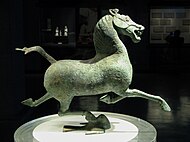 Flying Horse of Gansu
Flying Horse of Gansu Terracotta Army
Terracotta Army Changxin palace lamp, made of bronze & gold in the Western Han Dynasty, dated 172 BC, Hebei Museum. This palace lantern is entirely gilded, crafted in the shape of a kneeling palace maid holding a lamp. The characters "changxin shangyu" are inscribed on the bottom of the piece, hence the name Changxin Palace Lantern. The palace maid wears her hair in a bun with a head scarf, and is robed in a full-body garment, with spacious sleeves
Changxin palace lamp, made of bronze & gold in the Western Han Dynasty, dated 172 BC, Hebei Museum. This palace lantern is entirely gilded, crafted in the shape of a kneeling palace maid holding a lamp. The characters "changxin shangyu" are inscribed on the bottom of the piece, hence the name Changxin Palace Lantern. The palace maid wears her hair in a bun with a head scarf, and is robed in a full-body garment, with spacious sleeves Seated Buddha, Tang dynasty ca. 650.
Seated Buddha, Tang dynasty ca. 650. Black and white porcelian vase from Northern Song period (960-1126), in Asian Art Museum (San Francisco)
Black and white porcelian vase from Northern Song period (960-1126), in Asian Art Museum (San Francisco) The David Vases (Yuan dynasty, 1351 AD) in Room 95 of British Museum. These vases are among the most important examples of blue and white porcelain in existence because they are two of the oldest examples of this important Chinese innovation
The David Vases (Yuan dynasty, 1351 AD) in Room 95 of British Museum. These vases are among the most important examples of blue and white porcelain in existence because they are two of the oldest examples of this important Chinese innovation Detail of a handscroll painting with ink and colors on silk named Admonitions of the Instructress to the Court Ladies (女史箴圖), traditionally attributed to Gu Kaizhi(顧愷之, circa 344-406 AD), British Museum
Detail of a handscroll painting with ink and colors on silk named Admonitions of the Instructress to the Court Ladies (女史箴圖), traditionally attributed to Gu Kaizhi(顧愷之, circa 344-406 AD), British Museum Wang Xizhi Watching Geese, 1250-1300, by Qian Xuan (1235–1305), Metropolitan Museum of Art
Wang Xizhi Watching Geese, 1250-1300, by Qian Xuan (1235–1305), Metropolitan Museum of Art Glazed dragon tiles, circa 1480-1580 (Ming dynasty), height 39 cm, width 244 cm, British Museum. These large, high-relief ceramic tiles were made in sets to form a series of friezes showing blue and yellow dragons among lotuses. Por many years, they were part of a garden screen, but originally they ran along the ridge of a building in Shanxi province, supposedly protecting it from fire, as the dragon is associated with control of the water supply
Glazed dragon tiles, circa 1480-1580 (Ming dynasty), height 39 cm, width 244 cm, British Museum. These large, high-relief ceramic tiles were made in sets to form a series of friezes showing blue and yellow dragons among lotuses. Por many years, they were part of a garden screen, but originally they ran along the ridge of a building in Shanxi province, supposedly protecting it from fire, as the dragon is associated with control of the water supply Painting by the Chinese Ming Dynasty artist Chen Hongshou(1599-1652), leaf from an album of miscellaneous paintings
Painting by the Chinese Ming Dynasty artist Chen Hongshou(1599-1652), leaf from an album of miscellaneous paintings Jade vassel decorated with dragons, from Qianlong period (1736–95) of the Qing dynasty, in Metropolitan Museum of Art
Jade vassel decorated with dragons, from Qianlong period (1736–95) of the Qing dynasty, in Metropolitan Museum of Art
Japanese
Japanese art covers a wide range of art styles and media, including ancient pottery, sculpture, ink painting and calligraphy on silk and paper, ukiyo-e paintings and woodblock prints, ceramics, origami, and more recently manga—modern Japanese cartooning and comics—along with a myriad of other types. It has a long history, ranging from the beginnings of human habitation in Japan, sometime in the 10th millennium BC, to the present.
The first settlers of Japan, the Jōmon people (c. 11000 – c. 300 BC). They crafted lavishly decorated pottery storage vessels, clay figurines called dogū. Japan has been subject to sudden invasions of new ideas followed by long periods of minimal contact with the outside world. Over time the Japanese developed the ability to absorb, imitate, and finally assimilate those elements of foreign culture that complemented their aesthetic preferences. The earliest complex art in Japan was produced in the 7th and 8th centuries in connection with Buddhism. In the 9th century, as the Japanese began to turn away from China and develop indigenous forms of expression, the secular arts became increasingly important; until the late 15th century, both religious and secular arts flourished. After the Ōnin War (1467–1477), Japan entered a period of political, social, and economic disruption that lasted for over a century. In the state that emerged under the leadership of the Tokugawa shogunate, organized religion played a much less important role in people's lives, and the arts that survived were primarily secular.
 Wooden five-story pagoda of Hōryū-ji in Japan, built in the 7th century, one of the oldest wooden buildings in the world
Wooden five-story pagoda of Hōryū-ji in Japan, built in the 7th century, one of the oldest wooden buildings in the world- Kinkaku-ji is a Zen Buddhist temple in Kyoto (Japan). It is one of the most popular buildings in Japan, attracting a large number of visitors annually.
 Itsukushima Shrine, a Shinto shrineon the island of Itsukushima(popularly known as Miyajima), best known for its "floating" toriigate.
Itsukushima Shrine, a Shinto shrineon the island of Itsukushima(popularly known as Miyajima), best known for its "floating" toriigate. Bodhisattva Seishi (勢至菩薩) figure from the Muromachi period, half squating, half kneeling, his hands in the kongo gassho position, made between 1400 and 1600, wood and lacquer, in Rijksmuseum(Amsterdam, Netherlands)
Bodhisattva Seishi (勢至菩薩) figure from the Muromachi period, half squating, half kneeling, his hands in the kongo gassho position, made between 1400 and 1600, wood and lacquer, in Rijksmuseum(Amsterdam, Netherlands) Two women, a courtesan and her servant, and a dog, 1661 - 1672, painted on paper, in Rijksmuseum
Two women, a courtesan and her servant, and a dog, 1661 - 1672, painted on paper, in Rijksmuseum Daibutsu no bansho, Polychrome woodblock print, ink and color on paper, c. 1778, Metropolitan Museum of Art
Daibutsu no bansho, Polychrome woodblock print, ink and color on paper, c. 1778, Metropolitan Museum of Art Ogata Korin, Red and white plum trees, ink and colors on silver and gold on paper, 156.5 cm. 172.5 cm each
Ogata Korin, Red and white plum trees, ink and colors on silver and gold on paper, 156.5 cm. 172.5 cm each Print, made between 1780 and 1795, olychrome woodblock print, ink and color on paper, Metropolitan Museum of Art
Print, made between 1780 and 1795, olychrome woodblock print, ink and color on paper, Metropolitan Museum of Art Three Beauties of the Present Day, by Utamaro, c. 1793
Three Beauties of the Present Day, by Utamaro, c. 1793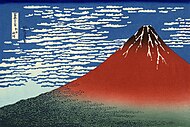 The print Red Fuji from Hokusai's series Thirty-six Views of Mount Fuji
The print Red Fuji from Hokusai's series Thirty-six Views of Mount Fuji Kuniyoshi Utagawa, Woman with fan
Kuniyoshi Utagawa, Woman with fan Nō mask from the 18th century, Metropolitan Museum of Art. Nō masks must be light, as they are worn throughout an entire performnce. Traditioally, each mask is carved out if a single piece of cypress wood
Nō mask from the 18th century, Metropolitan Museum of Art. Nō masks must be light, as they are worn throughout an entire performnce. Traditioally, each mask is carved out if a single piece of cypress wood- Japanese comb from Tokyo National Museum (Japan)
 Kitagawa Utamaro, Moonlight Revelry at Dozo Sagami, 18th century or 19th century, ink and color on paper, in Freer Gallery of Art
Kitagawa Utamaro, Moonlight Revelry at Dozo Sagami, 18th century or 19th century, ink and color on paper, in Freer Gallery of Art- Gintai shippō (銀胎七宝) vase with design of peacock feathers by Kawade Shibatarō, in Los Angeles County Museum of Art
 Woman kimono, late 19th - early 20th century, in Los Angeles County Museum of Art
Woman kimono, late 19th - early 20th century, in Los Angeles County Museum of Art
Korean
Korean arts include traditions in calligraphy, music, painting and pottery, often marked by the use of natural forms, surface decoration and bold colors or sounds.
The earliest examples of Korean art consist of stone age works dating from 3000 BC. These mainly consist of votive sculptures and more recently, petroglyphs, which were rediscovered.
This early period was followed by the art styles of various Korean kingdoms and dynasties. Korean artists sometimes modified Chinese traditions with a native preference for simple elegance, spontaneity, and an appreciation for purity of nature.
The Goryeo Dynasty (918–1392) was one of the most prolific periods for a wide range of disciplines, especially pottery.
The Korean art market is concentrated in the Insadong district of Seoul where over 50 small galleries exhibit and occasional fine arts auctions. Galleries are cooperatively run, small and often with curated and finely designed exhibits. In every town there are smaller regional galleries, with local artists showing in traditional and contemporary media. Art galleries usually have a mix of media. Attempts at bringing Western conceptual art into the foreground have usually had their best success outside of Korea in New York, San Francisco, London and Paris.
 The Dabotap Pagoda
The Dabotap Pagoda Dragon-shaped Celadon Ewer
Dragon-shaped Celadon Ewer Rock-carved triad buddha in Seosan, in South Chungcheong Province
Rock-carved triad buddha in Seosan, in South Chungcheong Province General View of Mt. Geumgang by Jeong Seon
General View of Mt. Geumgang by Jeong Seon Rafter finial in the shape of a dragon’s head and wind chime from the 10th century, in the Metropolitan Museum of Art
Rafter finial in the shape of a dragon’s head and wind chime from the 10th century, in the Metropolitan Museum of Art Gilt-bronze Maitreya in Meditation (National Treasure No. 83), unknown date, in the National Museum of Korea (Seoul)
Gilt-bronze Maitreya in Meditation (National Treasure No. 83), unknown date, in the National Museum of Korea (Seoul)
Vietnamese
Vietnamese art has a long and rich history, the earliest examples of which date back as far as the Stone Age around 8,000 BCE.
With the millennium of Chinese domination starting in the 2nd century BC, Vietnamese art undoubtedly absorbed many Chinese influences, which would continue even following independence from China in the 10th century AD. However, Vietnamese art has always retained many distinctively Vietnamese characteristics.
By the 19th century, the influence of French art took hold in Vietnam, having a large hand in the birth of modern Vietnamese art.
- Neolithic terracotta pieces used to imprint decoration patterns on cloth
 One Pillar Pagoda (from Hanoi) is an icon of Vietnamese culture; it was built in 1049, destroyed, and rebuilt in 1954
One Pillar Pagoda (from Hanoi) is an icon of Vietnamese culture; it was built in 1049, destroyed, and rebuilt in 1954 Sculpture from Central Vietnam, c. 10th century, in Metropolitan Museum of Art
Sculpture from Central Vietnam, c. 10th century, in Metropolitan Museum of Art Pagoda of the Celestial Lady(Vietnamese: Chùa Thiên Mụ; also called Linh Mụ Pagoda) in Huế, built in 1601
Pagoda of the Celestial Lady(Vietnamese: Chùa Thiên Mụ; also called Linh Mụ Pagoda) in Huế, built in 1601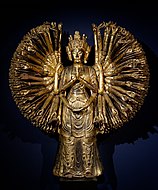 Statue of Avalokiteśvara Bodhisattva (Quán Thế Âm) of the Lê or Nguyễn Dynasty, Guimet Museum, Paris
Statue of Avalokiteśvara Bodhisattva (Quán Thế Âm) of the Lê or Nguyễn Dynasty, Guimet Museum, Paris Thiếu nữ bên hoa huệ (Young Woman with Lily), oil, 1943, by Tô Ngọc Vân
Thiếu nữ bên hoa huệ (Young Woman with Lily), oil, 1943, by Tô Ngọc Vân
Thai
Traditional Thai art is primarily composed of Buddhist art and scenes from the Indian epics. Traditional Thai sculpture almost exclusively depicts images of the Buddha. Traditional Thai paintings usually consist of book illustrations, and painted ornamentation of buildings such as palaces and temples.
 Head of Buddha from the second half of 14th century (Sukhothai), leaded bronze, traces of gilding, 43.3 cm (17 in), in the Walters Art Museum (Baltimore, United States)
Head of Buddha from the second half of 14th century (Sukhothai), leaded bronze, traces of gilding, 43.3 cm (17 in), in the Walters Art Museum (Baltimore, United States) Garudas in Wat Phra Kaew(Bangkok)
Garudas in Wat Phra Kaew(Bangkok) Thai sculpture made of bronze, from c. 15th century, H. 12 3/8 in. (31.4 cm); W. 7 1/4 in. (18.4 cm); D. 5 in. (12.7 cm), Metropolitan Museum of Art
Thai sculpture made of bronze, from c. 15th century, H. 12 3/8 in. (31.4 cm); W. 7 1/4 in. (18.4 cm); D. 5 in. (12.7 cm), Metropolitan Museum of Art Seated Buddha in "Maravijaya" from 1554 (?) (Lan Na), made of hollow cast bronze, in the Walters Art Museum. Lan Na Buddha images can be looked at in two ways: in terms of types (Sihing or non-Sihing) or modes and in terms of stylistic qualities. But in fact these two approaches overlap to a certain degree
Seated Buddha in "Maravijaya" from 1554 (?) (Lan Na), made of hollow cast bronze, in the Walters Art Museum. Lan Na Buddha images can be looked at in two ways: in terms of types (Sihing or non-Sihing) or modes and in terms of stylistic qualities. But in fact these two approaches overlap to a certain degree Architectural element that consist in glazed stoneware with underglaze brown painted decoration, 16th century, from Sawankhalok, Los Angeles County Museum of Art
Architectural element that consist in glazed stoneware with underglaze brown painted decoration, 16th century, from Sawankhalok, Los Angeles County Museum of Art Phra Maha Chedi Si Ratchakan at Wat Pho (Bangkok)
Phra Maha Chedi Si Ratchakan at Wat Pho (Bangkok) A page of the Phra Malai manuscript, circa 1860-1880, Opaque watercolor and ink on paper; Covers: gilded and lacquered paper, in the Los Angeles County Museum of Art
A page of the Phra Malai manuscript, circa 1860-1880, Opaque watercolor and ink on paper; Covers: gilded and lacquered paper, in the Los Angeles County Museum of Art- Hanuman on his chariot, a scene from the Ramakien in Wat Phra Kaew (Bangkok), from the Bangkok period
Cambodian
The history of Cambodian art stretches back centuries to ancient times, but the most famous period is undoubtedly the Khmer art of the Khmer Empire (802–1431), especially in the area around Angkor and the mainly 12th-century temple-complex of Angkor Wat, initially Hindu and subsequently Buddhist. After the collapse of the empire these and other sites were abandoned and overgrown, allowing much of the era's stone carving and architecture to survive to the present day. Traditional Cambodian arts and crafts include textiles, non-textile weaving, silversmithing, stone carving, lacquerware, ceramics, wat murals, and kite-making.
Beginning in the mid-20th century, a tradition of modern art began in Cambodia, though in the later 20th century both traditional and modern arts declined for several reasons, including the killing of artists by the Khmer Rouge. The country has experienced a recent artistic revival due to increased support from governments, NGOs, and foreign tourists.
In pre-colonial Cambodia, art and crafts were generally produced either by rural non-specialists for practical use or by skilled artists producing works for the Royal Palace. In modern Cambodia, many artistic traditions entered a period of decline or even ceased to be practiced, but the country has experienced a recent artistic revival as the tourist market has increased and governments and NGOs have contributed to the preservation of Cambodian culture.
 Lintel made in the Preah Ko style, exhibited in Musée Guimet (Paris)
Lintel made in the Preah Ko style, exhibited in Musée Guimet (Paris)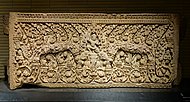 Lintel from the Angkor period (circa 900 CE), made of sandstone, Tokyo National Museum
Lintel from the Angkor period (circa 900 CE), made of sandstone, Tokyo National Museum- Relief made in the pre-rup style, corca 950-975
 Stone carving at Banteay Srei, an Angkorian temple consecrated in 967 CE
Stone carving at Banteay Srei, an Angkorian temple consecrated in 967 CE Angkor Wat, an icon of Cambodia
Angkor Wat, an icon of Cambodia Head of Avalokiteshvara, mid-12th century or later, made of sandstone, Los Angeles County Museum of Art
Head of Avalokiteshvara, mid-12th century or later, made of sandstone, Los Angeles County Museum of Art Singha (lion) from Angkor period (circa 1100-1200 CE), made of sandstone, exhibited in Tokyo National Museum (Japan)
Singha (lion) from Angkor period (circa 1100-1200 CE), made of sandstone, exhibited in Tokyo National Museum (Japan) Votive stupa made of copper alloy, 12th-13th century, Los Angeles County Museum of Art
Votive stupa made of copper alloy, 12th-13th century, Los Angeles County Museum of Art Stone bas-relief at Bayon temple depicting the Khmer army at war with the Cham, carved c. 1200 CE
Stone bas-relief at Bayon temple depicting the Khmer army at war with the Cham, carved c. 1200 CE- Shadow play from Cambodia
Indonesian
It is quite difficult to define Indonesian art, since the country is immensely diverse. The sprawling archipelago nation consists of 13,466 islands. Around 922 of those permanently inhabited, by over 300 ethnic groups, which speaking more than 700 living languages.
Indonesia also has experienced a long history, with each period leaves a distinctive arts. From prehistoric cave paintings and megalithic ancestral statues of Central Sulawesi, tribal wooden carving traditions of Toraja and Asmat people, graceful Hindu-Buddhist art of classical Javanese civilization which produced Borobudur and Prambanan, vivid Balinese paintings and performing arts, Islamic arts of Aceh, to contemporary arts of modern Indonesian artists. Both Indonesian diversity and history add to complexity on defining and identifying what is Indonesian art.
 Prambanan temple, Special Region of Yogyakarta
Prambanan temple, Special Region of Yogyakarta- Prajñāpāramitā statue from East Java
 Relief from Borobodur that represents prince Siddhartha Gautama became an ascetic hermit
Relief from Borobodur that represents prince Siddhartha Gautama became an ascetic hermit- Relief panel of a ship at Borobudur
 Metalwork from Java, first half of the 10th century, made of bronze, in Metropolitan Museum of Art
Metalwork from Java, first half of the 10th century, made of bronze, in Metropolitan Museum of Art Great Departure from Lalitavistara
Great Departure from Lalitavistara- Arjuna in Javanese wayang show
 Javanese shadow puppet (wayang kulit) of character Gathutkaca
Javanese shadow puppet (wayang kulit) of character Gathutkaca
Africa
African art includes both sculpture, typified by the brass castings of the Benin people, as well as folk art. Concurrent with the European Middle Ages, in the eleventh century CE a nation that made grand architecture, gold sculpture, and intricate jewelry was founded in Great Zimbabwe. Impressive sculpture was concurrently being cast from brass by the Yoruba people of what is now Nigeria. Such a culture grew and was ultimately transformed to become the Benin Kingdom, where elegant altar tusks, brass heads, plaques of brass, and palatial architecture was created. The Benin Kingdom was ended by the British in 1897, and little of the culture's art now remains in Nigeria. Today, the most significant arts venue in Africa is the Johannesburg Biennale.
Sub-Saharan Africa is characterized by a high density of cultures. Notable are the Nok, Edo, Yoruba, and Igbo people from Nigeria; Kuba people from Central Africa; Djenné people from Mali; Ashanti peoplefrom Ghana; Zulu people from Southern Africa; and Fang people from Equatorial Guinea (85%), Cameroon & Gabon.
 Helmet mask for Sande Society Brooklyn Museum
Helmet mask for Sande Society Brooklyn Museum Sculpture from Guinea-Bissau
Sculpture from Guinea-Bissau- One of many Yoruba bronze headsfrom Ife
- Terracotta seated figure from Mali, 13th century, earthenware, 29.9 cm (11⁄4 in) high, Metropolitan Museum of Art. The raised marks and indentations on the back of this hunched Djenné figure may represent disease or, more likely, sacrification patterns. The facial expression and pose could depict an individual in mouring or in pain
 Two Bambara Chiwara c. late 19th early 20th centuries, Art Institute of Chicago. Female (left) and male Vertical styles
Two Bambara Chiwara c. late 19th early 20th centuries, Art Institute of Chicago. Female (left) and male Vertical styles Wooden figure from Mambila(Nigeria), Musée du quai Branly(Paris)
Wooden figure from Mambila(Nigeria), Musée du quai Branly(Paris)- The Golden Rhinoceros of Mapungubwe, Mapungubwe Collection, University of Pretoria Museums
 Yombe-sculpture, 19th century
Yombe-sculpture, 19th century- Sculpture of a "Queen Mother" from Kingdom of Benin, 16th century
 Nok seated figure, 5th century BC – 5th century AD, terracotta, 38 cm (1 ft 3 in), Musée du quai Branly(Paris). In this Nok work, the head is dramatically larger than the body supoorting it, yet the figure possesses elegant details and a powerfull focus. The neat protrusion from the chin represents a beard. Necklaces from a cone around the neck and keep the focus on the face
Nok seated figure, 5th century BC – 5th century AD, terracotta, 38 cm (1 ft 3 in), Musée du quai Branly(Paris). In this Nok work, the head is dramatically larger than the body supoorting it, yet the figure possesses elegant details and a powerfull focus. The neat protrusion from the chin represents a beard. Necklaces from a cone around the neck and keep the focus on the face- Nok artwork, 5th century BC – 5th century AD, length: 50 cm (19.6 in); height: 54 cm (21.2 in); width: 50 cm (19.6 in), terracotta, Musée du quai Branly
 A Benin Bronze plaque with warriors
A Benin Bronze plaque with warriors Ndop are royal memorial portraits caverd by the Kuba people of Central Africa. They are not naturalistic portrayals but are intended as representations of the king's spirit and as an encapsulation of the principal of kingship. It represents king Mishe miShyaang maMbul
Ndop are royal memorial portraits caverd by the Kuba people of Central Africa. They are not naturalistic portrayals but are intended as representations of the king's spirit and as an encapsulation of the principal of kingship. It represents king Mishe miShyaang maMbul Wabele mask, 35 x 9 x 14 in. (88.9 x 22.9 x 35.6 cm), made by the Senufo people in the early 20th century, Brooklyn Museum
Wabele mask, 35 x 9 x 14 in. (88.9 x 22.9 x 35.6 cm), made by the Senufo people in the early 20th century, Brooklyn Museum This trophy head, made of pure gold, represents an enemy chief killed in battle. Weighing 1.5 kg (3.3 lb), it was attached to the Asante king's state sword. Part of Wallace Collection (London). Circa 1870
This trophy head, made of pure gold, represents an enemy chief killed in battle. Weighing 1.5 kg (3.3 lb), it was attached to the Asante king's state sword. Part of Wallace Collection (London). Circa 1870 16th century ivory portrait of Queen Mother Idia, Metropolitan Museum of Art. One of four related ivory pendant masks among the prized regalia of the Oba of Benintaken by the British during the Benin Expedition of 1897
16th century ivory portrait of Queen Mother Idia, Metropolitan Museum of Art. One of four related ivory pendant masks among the prized regalia of the Oba of Benintaken by the British during the Benin Expedition of 1897
Oceania
The Art of Oceania includes the geographic areas of Micronesia, Polynesia, Australia, New Zealand, and Melanesia. One approach treats the area thematically, with foci on ancestry, warfare, the body, gender, trade, religion, and tourism. Unfortunately, little ancient art survives from Oceania. Scholars believe that this is likely because artists used perishable materials, such as wood and feathers, which did not survive in the tropical climate, and there are no historical records to refer to most of this material. The understanding of Oceania's artistic cultures thus begins with the documentation of it by Westerners, such as Captain James Cook in the eighteenth century. At the turn of the twentieth century the French artist Paul Gauguin spent significant amounts of time in Tahiti, living with local people and making modern art—a fact that has become intertwined with Tahitian visual culture to the present day. The indigenous art of Australia often looks like abstract modern art, but it has deep roots in local culture.
The art of Oceania is the last great tradition of art to be appreciated by the world at large. Despite being one of the longest continuous traditions of art in the world, dating back at leasf fifty millennia, it remained relatively unknown until the second half of the 20th century.
The often ephemeral materials of Oceanic art makes it difficult to determine the antiquity of the majority of the forms of art practised today. The most durable forms are the multitudes of rock engravings and rock paintings which are found across the continent. In the Arnhem Land escarpment, evidence suggests that paintings were being made fifty thousand years ago, antedating the Palaeolithic rock paintings of Altamira & Lascaux in Europe.
 Moai at Rano Raraku, Easter Island
Moai at Rano Raraku, Easter Island Detail from a māorian tāhūhū from c. 1840
Detail from a māorian tāhūhū from c. 1840 A hei-tiki made of pounamu (a harder kind of nefrite) and sea shells
A hei-tiki made of pounamu (a harder kind of nefrite) and sea shells Polynesian wooden sculpture
Polynesian wooden sculpture The Statue of A'a from Rurutu. This statue represents the god A'a and was made on the Island of Rurutuin the Pacific Ocean. It was one of a number of figures presented to a mission station by the Rurutuans in 1821 as a symbol of their acceptance of Christianity
The Statue of A'a from Rurutu. This statue represents the god A'a and was made on the Island of Rurutuin the Pacific Ocean. It was one of a number of figures presented to a mission station by the Rurutuans in 1821 as a symbol of their acceptance of Christianity An Uli figure from New Ireland, circa 1890, painted wood, 155 cm (61 in) high, in Musée du quai Branly. The hermaphrodite Uli figures probably symbolized the connection between paternal and maternal life energy in initiation ceremonies
An Uli figure from New Ireland, circa 1890, painted wood, 155 cm (61 in) high, in Musée du quai Branly. The hermaphrodite Uli figures probably symbolized the connection between paternal and maternal life energy in initiation ceremonies- This monumental carving of the head and torso of a man, from British Museum, is known as Hoa Hakananai'a (stolen or hidden friend). Easter Island is famous for monolithic basalt statues (moai) such as this one. They were probably carved to commemorate important ancestors
 Dinonga eidu (idol), from Caroline islands, circa 1800, made of wood, 35 cm (13⁄4 in) high, in Musée du quai Branly (Paris). The initiated can distinghish between the masterfully stylized figures of male and female spirits and deities
Dinonga eidu (idol), from Caroline islands, circa 1800, made of wood, 35 cm (13⁄4 in) high, in Musée du quai Branly (Paris). The initiated can distinghish between the masterfully stylized figures of male and female spirits and deities Bradshaw rock paintings, north-west Kimberley region of Western Australia
Bradshaw rock paintings, north-west Kimberley region of Western Australia Aboriginal rock art, Anbangbang Rock Shelter, Kakadu National Park (Australia)
Aboriginal rock art, Anbangbang Rock Shelter, Kakadu National Park (Australia)- Artwork form northern Australia, Musée du quai Branly (Paris)
 A closeup of a rongorongo tablet
A closeup of a rongorongo tablet
Modern and contemporary
Origins
Art historians disagree when Modern art began, some tracing it as far back as Francisco Goya in the Napoleonic period, the mid-19th century with the industrial revolution or the late 19th century with the advent of Impressionism. The French Revolution of 1789 gave rise to further revolutions in thought. In the arts, these included a new self-consciousness about artistic styles and individuality. Art historian H. Harvard Arnason says "a gradual metamorphosis took place in the course of a hundred years", marked by significant events such as the completion in 1784 of Jacques-Louis David's painting The Oath of the Horatii; the exhibition of Gustave Courbet's painting The Artist's Studio in 1855; and the exhibition of Édouard Manet's painting Le déjeuner sur l'herbe in the Salon des Refusés in Paris in 1863.
19th century
During the 19th century, the Romantic tendency of early modern artists such as Turner and Delacroix was succeeded by newer art movements: Realism,Impressionism, post-Impressionism, Symbolism, and other movements. Western artists were influenced by Eastern decorative arts, especially Japanese prints.
The Impressionists sought to convey movement, spontaneity, and transient effects of light in their work. Their style was adopted by artists in many countries, alongside national movements such as the Hudson River School and the Ashcan School in the US.
 Francisco de Goya, The Third of May 1808, 1814
Francisco de Goya, The Third of May 1808, 1814 Gustave Courbet, The Artist's Studio (L'Atelier du peintre): A Real Allegory of a Seven Year Phase in my Artistic and Moral Life, 1855, Musée d'Orsay, Paris
Gustave Courbet, The Artist's Studio (L'Atelier du peintre): A Real Allegory of a Seven Year Phase in my Artistic and Moral Life, 1855, Musée d'Orsay, Paris Édouard Manet, Le Déjeuner sur l'herbe, 1863, Musée d'Orsay, Paris
Édouard Manet, Le Déjeuner sur l'herbe, 1863, Musée d'Orsay, Paris Claude Monet, Impression, Sunrise(Impression, soleil levant), 1872; the painting that gave its name to the style and artistic movement, Musée Marmottan Monet (Paris)
Claude Monet, Impression, Sunrise(Impression, soleil levant), 1872; the painting that gave its name to the style and artistic movement, Musée Marmottan Monet (Paris) Georges Seurat, A Sunday Afternoon on the Island of La Grande Jatte, 1884–86, oil on canvas, 207.5 × 308.1 cm, Art Institute of Chicago
Georges Seurat, A Sunday Afternoon on the Island of La Grande Jatte, 1884–86, oil on canvas, 207.5 × 308.1 cm, Art Institute of Chicago Vincent van Gogh, Country road in Provence by Night, 1889, May 1890, Kröller-Müller Museum
Vincent van Gogh, Country road in Provence by Night, 1889, May 1890, Kröller-Müller Museum Henri Rousseau, Tiger in a Tropical Storm (Surprised!), 1891
Henri Rousseau, Tiger in a Tropical Storm (Surprised!), 1891 Henri de Toulouse-Lautrec, At the Moulin Rouge: Two Women Waltzing, 1892
Henri de Toulouse-Lautrec, At the Moulin Rouge: Two Women Waltzing, 1892 Paul Cézanne, The Large Bathers, 1898–1905
Paul Cézanne, The Large Bathers, 1898–1905- Paul Gauguin, Spirit of the Dead Watching 1892, Albright-Knox Art Gallery
 Edvard Munch, The Scream, 1893
Edvard Munch, The Scream, 1893 Alphonse Mucha, F. Champenois Imprimeur-Éditeur, 1897, lithograph
Alphonse Mucha, F. Champenois Imprimeur-Éditeur, 1897, lithograph
Early 20th century
The history of 20th-century art is a narrative of endless possibilities and the search for new standards, each being torn down in succession by the next. The art movements of Fauvism, Expressionism, Cubism, abstract art, Dadaism and Surrealism led to further explorations of new creative styles and manners of expression. Increasing globalinteraction during this time saw an equivalent influence of other cultures into Western art, such as Pablo Picasso being influenced by Iberian sculpture, African sculptureand Primitivism. Japonism, and Japanese woodcuts (which had themselves been influenced by Western Renaissance draftsmanship) had an immense influence on Impressionism and subsequent artistic developments. The influential example set by Paul Gauguin's interest in Oceanic art and the sudden popularity among the cognoscenti in early 20th century Paris of newly discovered African fetish sculptures and other works from non-European cultures were taken up by Picasso, Henri Matisse, and many of their colleagues. Later in the 20th century, Pop Art and Abstract Expressionism came to prominence.
 Henri Matisse, Woman with a Hat, 1905, San Francisco Museum of Modern Art
Henri Matisse, Woman with a Hat, 1905, San Francisco Museum of Modern Art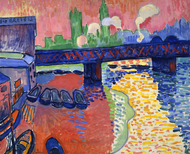 André Derain, 1906, Charing Cross Bridge, London, National Gallery of Art, Washington, D.C.
André Derain, 1906, Charing Cross Bridge, London, National Gallery of Art, Washington, D.C. Gustav Klimt, Portrait of Adele Bloch-Bauer I, 1907, Neue Galerie New York
Gustav Klimt, Portrait of Adele Bloch-Bauer I, 1907, Neue Galerie New York Constantin Brâncuși, The Kiss, 1907–08
Constantin Brâncuși, The Kiss, 1907–08 Georges Braque, Houses at l'Estaque, 1908, Kunstmuseum Bern
Georges Braque, Houses at l'Estaque, 1908, Kunstmuseum Bern Egon Schiele, Self Portrait with Physalis, 1912, Leopold Museum
Egon Schiele, Self Portrait with Physalis, 1912, Leopold Museum Marcel Duchamp, Nude Descending a Staircase, No. 2, 1912, Philadelphia Museum of Art
Marcel Duchamp, Nude Descending a Staircase, No. 2, 1912, Philadelphia Museum of Art Robert Delaunay, 1912–13, Le Premier Disque, Private collection
Robert Delaunay, 1912–13, Le Premier Disque, Private collection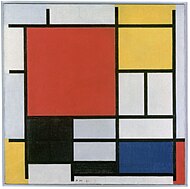 Piet Mondrian, Composition with Red, Yellow, Blue, and Black, 1921, Gemeentemuseum Den Haag
Piet Mondrian, Composition with Red, Yellow, Blue, and Black, 1921, Gemeentemuseum Den Haag
Late 20th and early 21st centuries
Rapid advances in science and technology led to the late Modern and Postmodern period. In these periods, the art and cultures of the world went through many changes, and there was a great deal of intermixture between cultures, as new communications technologies facilitated the national and even global dissemination of music, art and style. The separation of regional cultures that had marked the 19th century was replaced by a global culture. Postmodernism describes a broad movement that developed in the mid- to late-20th century across philosophy, the arts, architecture, and criticism which marked a departure from modernism.
 Henry Moore, Reclining Figure, 1951, painted plaster, Fitzwilliam Museum, Cambridge
Henry Moore, Reclining Figure, 1951, painted plaster, Fitzwilliam Museum, Cambridge Yves Klein, IKB 191, 1962, monochrome painting
Yves Klein, IKB 191, 1962, monochrome painting- Joan Miró, Dona i Ocell, 1983, Parc Joan Miró, Barcelona
Text is available under the Creative Commons Attribution-ShareAlike License
